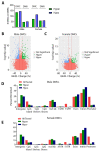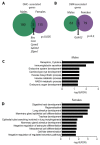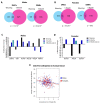Perinatal Lead Exposure Promotes Sex-Specific Epigenetic Programming of Disease-Relevant Pathways in Mouse Heart
- PMID: 36668811
- PMCID: PMC9860846
- DOI: 10.3390/toxics11010085
Perinatal Lead Exposure Promotes Sex-Specific Epigenetic Programming of Disease-Relevant Pathways in Mouse Heart
Abstract
Environmental contaminants such as the metal lead (Pb) are associated with cardiovascular disease, but the underlying molecular mechanisms are poorly understood. In particular, little is known about how exposure to Pb during early development impacts the cardiac epigenome at any point across the life course and potential differences between sexes. In a mouse model of human-relevant perinatal exposures, we utilized RNA-seq and Enhanced Reduced Representation Bisulfite Sequencing (ERRBS) to investigate the effects of Pb exposure during gestation and lactation on gene expression and DNA methylation, respectively, in the hearts of male and female mice at weaning. For ERRBS, we identified differentially methylated CpGs (DMCs) or differentially methylated 1000 bp regions (DMRs) based on a minimum absolute change in methylation of 10% and an FDR < 0.05. For gene expression data, an FDR < 0.05 was considered significant. No individual genes met the FDR cutoff for gene expression; however, we found that Pb exposure leads to significant changes in the expression of gene pathways relevant to cardiovascular development and disease. We further found that Pb promotes sex-specific changes in DNA methylation at hundreds of gene loci (280 DMCs and 99 DMRs in males, 189 DMCs and 121 DMRs in females), and pathway analysis revealed that these CpGs and regions collectively function in embryonic development. In males, differential methylation also occurred at genes related to immune function and metabolism. We then investigated whether genes exhibiting differential methylation at weaning were also differentially methylated in hearts from a cohort of Pb-exposed mice at adulthood. We found that a single gene, Galnt2, showed differential methylation in both sexes and time points. In a human cohort investigating the influence of prenatal Pb exposure on the epigenome, we also observed an inverse association between first trimester Pb concentrations and adolescent blood leukocyte DNA methylation at a locus in GALNT2, suggesting that this gene may represent a biomarker of Pb exposure across species. Together, these data, across two time points in mice and in a human birth cohort study, collectively demonstrate that Pb exposure promotes sex-specific programming of the cardiac epigenome, and provide potential mechanistic insight into how Pb causes cardiovascular disease.
Keywords: DNA methylation; Developmental Origins of Health and Disease (DOHaD); cardiovascular disease; epigenetic; heart; sex differences; toxicoepigenetics.
Conflict of interest statement
The authors declare no conflict of interest.
Figures






Similar articles
-
Perinatal Exposure to Lead or Diethylhexyl Phthalate in Mice: Sex-Specific Effects on Cardiac DNA Methylation and Gene Expression across Time.Environ Health Perspect. 2025 Jun;133(6):67014. doi: 10.1289/EHP15503. Epub 2025 Jun 16. Environ Health Perspect. 2025. PMID: 40315424 Free PMC article.
-
Effects of Developmental Lead and Phthalate Exposures on DNA Methylation in Adult Mouse Blood, Brain, and Liver: A Focus on Genomic Imprinting by Tissue and Sex.Environ Health Perspect. 2024 Jun;132(6):67003. doi: 10.1289/EHP14074. Epub 2024 Jun 4. Environ Health Perspect. 2024. PMID: 38833407 Free PMC article.
-
Maternal and neonatal outcomes of elective induction of labor.Evid Rep Technol Assess (Full Rep). 2009 Mar;(176):1-257. Evid Rep Technol Assess (Full Rep). 2009. PMID: 19408970 Free PMC article.
-
Drugs for preventing postoperative nausea and vomiting in adults after general anaesthesia: a network meta-analysis.Cochrane Database Syst Rev. 2020 Oct 19;10(10):CD012859. doi: 10.1002/14651858.CD012859.pub2. Cochrane Database Syst Rev. 2020. PMID: 33075160 Free PMC article.
-
Antiretrovirals for reducing the risk of mother-to-child transmission of HIV infection.Cochrane Database Syst Rev. 2011 Jul 6;(7):CD003510. doi: 10.1002/14651858.CD003510.pub3. Cochrane Database Syst Rev. 2011. PMID: 21735394
Cited by
-
Sex-stratified piRNA expression analysis reveals shared functional impacts of perinatal lead (Pb) exposure in murine hearts.Epigenetics. 2025 Dec;20(1):2542879. doi: 10.1080/15592294.2025.2542879. Epub 2025 Aug 10. Epigenetics. 2025. PMID: 40785069 Free PMC article.
-
Pathological epigenetic events and reversibility review: the intersection between hallmarks of aging and developmental origin of health and disease.Epigenomics. 2023 Jul;15(14):741-754. doi: 10.2217/epi-2023-0224. Epub 2023 Sep 5. Epigenomics. 2023. PMID: 37667910 Free PMC article. Review.
-
Firefighting, per- and polyfluoroalkyl substances, and DNA methylation of genes associated with prostate cancer risk.Environ Mol Mutagen. 2024 Jan-Feb;65(1-2):55-66. doi: 10.1002/em.22589. Epub 2024 Mar 24. Environ Mol Mutagen. 2024. PMID: 38523457 Free PMC article.
-
Perinatal Exposure to Lead or Diethylhexyl Phthalate in Mice: Sex-Specific Effects on Cardiac DNA Methylation and Gene Expression across Time.Environ Health Perspect. 2025 Jun;133(6):67014. doi: 10.1289/EHP15503. Epub 2025 Jun 16. Environ Health Perspect. 2025. PMID: 40315424 Free PMC article.
-
Translational toxicoepigenetic Meta-Analyses identify homologous gene DNA methylation reprogramming following developmental phthalate and lead exposure in mouse and human offspring.Environ Int. 2024 Apr;186:108575. doi: 10.1016/j.envint.2024.108575. Epub 2024 Mar 11. Environ Int. 2024. PMID: 38507935 Free PMC article.
References
-
- Chowdhury R., Ramond A., O’Keeffe L.M., Shahzad S., Kunutsor S.K., Muka T., Gregson J., Willeit P., Warnakula S., Khan H., et al. Environmental toxic metal contaminants and risk of cardiovascular disease: Systematic review and meta-analysis. BMJ. 2018;362:k3310. doi: 10.1136/bmj.k3310. - DOI - PMC - PubMed
Grants and funding
- ES017885/ES/NIEHS NIH HHS/United States
- K01 ES032048/ES/NIEHS NIH HHS/United States
- ES032048/ES/NIEHS NIH HHS/United States
- ES028802/ES/NIEHS NIH HHS/United States
- ES031686/ES/NIEHS NIH HHS/United States
- R01 ES028802/ES/NIEHS NIH HHS/United States
- R01 AG072396/AG/NIA NIH HHS/United States
- P01 ES022844/ES/NIEHS NIH HHS/United States
- ES026553/ES/NIEHS NIH HHS/United States
- R01 ES007062/ES/NIEHS NIH HHS/United States
- ES007062/ES/NIEHS NIH HHS/United States
- P30 ES017885/ES/NIEHS NIH HHS/United States
- R01 AG067592/AG/NIA NIH HHS/United States
- ES026697/ES/NIEHS NIH HHS/United States
- U01 ES026697/ES/NIEHS NIH HHS/United States
- T32 ES007062/ES/NIEHS NIH HHS/United States
- R35 ES031686/ES/NIEHS NIH HHS/United States
LinkOut - more resources
Full Text Sources
Miscellaneous

